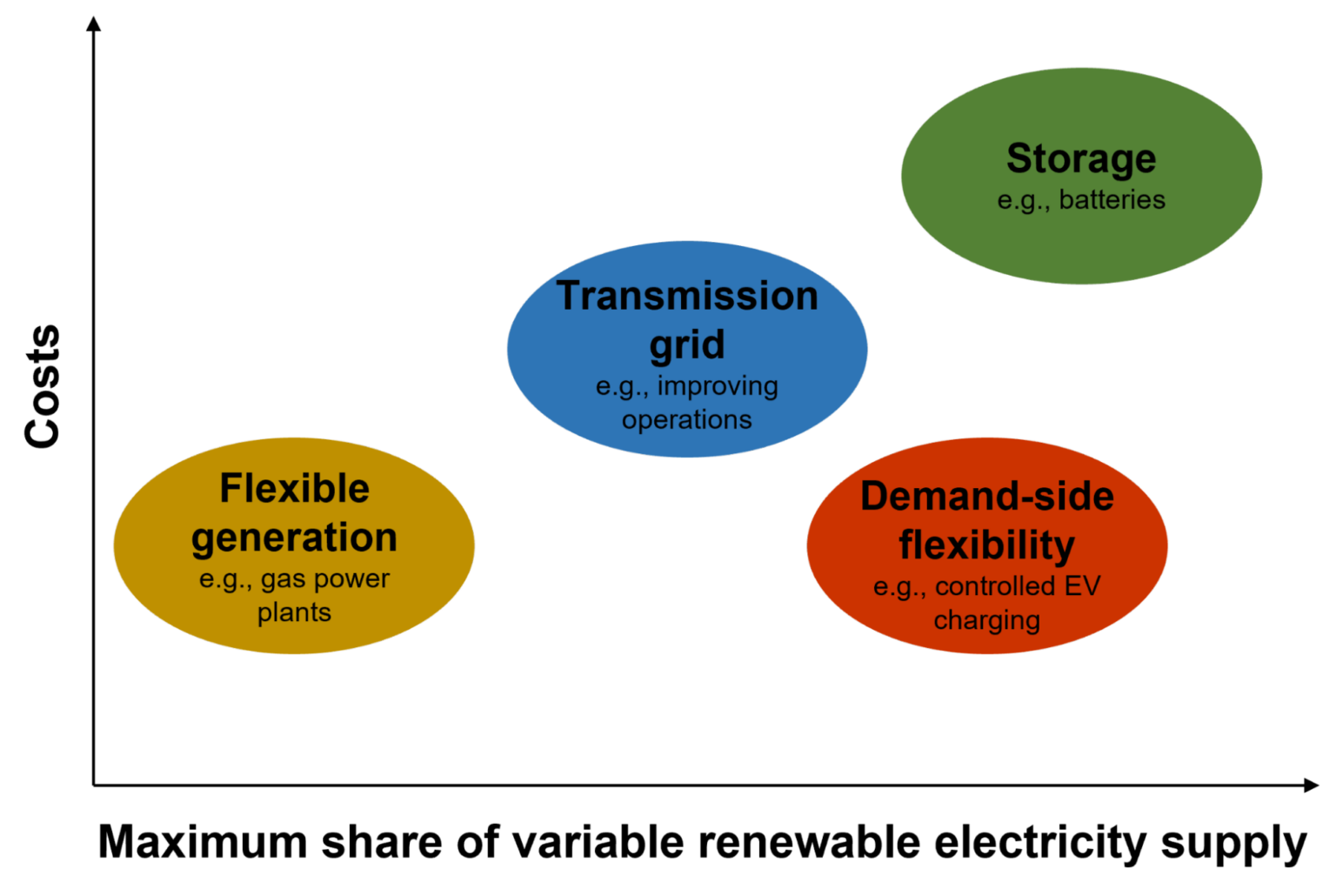
Why and how to put demand-side flexibility at the heart of the zero-carbon electricity transition
On 16.03.2023 by Christine Johanna GschwendtnerBy Christine Gschwendtner

Christine Gschwendtner has recently finished her PhD in the Group for Sustainability and Technology at ETH Zurich and is now a Postdoctoral Researcher at Harvard University. Her research focuses on how to support the adoption and integration of low-carbon technologies with focus on sector coupling and heterogeneous behavioral aspects. Current research projects investigate incentives for leveraging the spatial-temporal flexibility of electricity demand, particularly related to electrification, e.g., electric vehicles/vehicle-to-grid and heat pumps.
Electricity systems require more and more flexibility to integrate increasing shares of variable renewable electricity and avoid costly grid expansion. The demand side – involving electricity end-users – will be key in providing relatively cheap flexibility. Looking beyond the technical aspects is crucial to leverage this potential; namely, by addressing social and regulatory challenges. Effective compensation mechanisms for providing flexibility and procurement strategies for different services, particularly at the distribution grid level, need to be established while enabling the participation of small flexibility providers.
The need for flexibility and why the demand side is crucial
Accelerating the deployment of variable wind and solar electricity and electrifying transport and heating increases the challenge of ensuring that supply can meet demand at any time. For instance, solar electricity generation is highest during midday whereas electric vehicles (EVs) can increase the evening peak demand (Figure 1). To balance electricity supply and demand, an increasing amount of flexibility is required, which is one of the key challenges for the transition to a zero-carbon electricity system. Flexibility is the change in feed-in or withdrawal of electricity, which can provide different services. Examples of flexibility services include transmission grid services, e.g., maintaining grid frequency, distribution grid services, e.g., voltage control or congestion management, or services for energy suppliers, e.g., curtailment reduction.

These services can be provided by four main sources of flexibility and Figure 2 indicates their relative costs and maximum share of variable renewable electricity supply. Future electricity systems likely require a mix of these flexibility sources as they can complement each other.
– Demand-side flexibility stands out for its relatively low costs and can facilitate high variable renewable electricity supply by providing short-term flexibility. For example, EVs can shift their charging to midday or feed-in electricity from their batteries at times of high demand by using vehicle-to-grid (V2G). Low infrastructure costs (e.g., digitization of grids, smart meters) lead to an advantage compared to other flexibility sources, e.g., storage technologies. While industry has participated in demand-side flexibility for decades, the increasing diffusion of EVs and heat pumps leads to a high flexibility potential for residential and commercial customers, supporting the integration of high shares of variable renewable electricity.
– Demand-side flexibility will be increasingly valuable as flexible generation declines as a traditional flexibility source because fewer flexible power plants are included in a system with an increasing share of renewable electricity supply. Regarding costs, flexible power plants are currently available at relatively low costs but will have lower load-factors in a system with high shares of renewable electricity, which increases costs. Additionally, the curtailment of wind or PV electricity supply is costly and can increase emissions. Therefore, flexible generation is an increasingly economically and environmentally unattractive flexibility source.
– Transmission grids can transport electricity to different areas and thereby balance supply and demand across areas, including between countries with interconnections. While the use of existing transmission grids can be improved, expansion costs can be high but would still be much lower than overbuilding renewables and energy storage to reach the same decarbonization goals. However, with high shares of renewable electricity in neighboring areas, excess electricity might occur simultaneously, limiting the potential of transmission grids as a flexibility source.
– Storage can provide centralized (e.g., pumped hydro storage) or distributed (e.g., residential battery storage) flexibility. Grid-scale battery storage is increasingly used for short-term balancing. Although storage will be important, its scale and associated costs depend on the use of other flexibility sources, particularly demand-side flexibility, which can also act as distributed storage.
Overall, the demand side shows high potential for providing short-term flexibility at low costs for systems with high shares of variable renewable electricity supply, outperforming several other flexibility sources. So, why is demand-side flexibility not yet widely implemented beyond pilot projects?
Challenges for demand-side flexibility and steps forward
There are two main challenges for advancing residential demand-side flexibility: social and regulatory. However, both can be overcome with targeted actions:
- Social challenge: Demand-side flexibility depends on user behavior, which cannot be fully controlled. As the reaction to price signals is uncertain because users might not change their behavior due to perceived inconvenience, habits or personal preferences, grid operators consider demand-side flexibility as unreliable. Would you be willing to let your EV charge and discharge while you don’t need it? At the same time, justice concerns arise as low-income households may be excluded from flexibility provision and the associated financial benefits.
Steps forward: Pilot projects have shown that compensation is important for mass participation in demand-side flexibility. Consequently, appropriate price signals should be developed that are simple enough to support their adoption while incorporating trade-offs between flexibility services across transmission, distribution, and generation levels. Due to diverse users and behaviors, there might not be a one-size-fits-all solution to incentivizing demand-side flexibility and considering low-income groups is crucial. Experimenting with opt-in (the users need to choose to participate) versus opt-out (the users need to choose to not participate) concepts could gain more insights on how to maximize user choice while maximizing demand-side flexibility. To increase reliability of demand-side flexibility, portfolios of different technologies (e.g., EVs and heat pumps) and diverse user types (e.g. different socio-demographic groups, commercial and residential users) can balance variations of flexibility provision by different users. - Regulatory challenge: Even if users would be willing to widely participate in demand-side flexibility, regulatory barriers need to be removed to unlock demand-side participation. Two key barriers are the restricted participation of small providers and developing procurement strategies for different flexibility services. Small providers might not be able to fulfill flexibility market requirements, such as being able to provide a certain amount of power for a given duration, e.g., 1 MW for 4 hours. While the procurement of flexibility is long established at transmission level, it is unclear how flexibility can be acquired at distribution level.
Steps forward: To enable the participation of small providers, aggregators can pool several small flexibility providers to participate collectively in the markets. Some countries have already shortened the durations, e.g., to 4h in the frequency curtailment market in Denmark and Germany. Where markets are not yet established, different options are currently tested in pilot projects: markets, time-varying electricity prices, auctions or tenders, e.g., the flexibility platform piclo. Starting behind-the-meter by, e.g., optimizing EV charging with roof-top PV supply, can avoid the grid interface while developing solutions for other flexibility services.
Demand-side flexibility has the potential to be an effective and cost-competitive way to integrate variable renewable electricity and avoid grid expansion needs. However, to leverage its potential, the focus needs to shift beyond the technical components, recognizing the strong dependence on social aspects while removing regulatory barriers. Crucial next steps are therefore developing effective compensation mechanisms for different flexibility services and diverse users as well as establishing procurement strategies for flexibility of small providers, particularly at distribution level.
Cover photo by © [Jiri Hera] / Adobe Stock
Keep up with the Energy Blog @ ETH Zurich on Twitter @eth_energy_blog.
Suggested citation: Gschwendtner, Christine. “Why and how to put demand-side flexibility at the heart of the zero-carbon electricity transition”, Energy Blog @ ETH Zurich, ETH Zurich, March 16, 2023, https://blogs.ethz.ch/energy/why-and-how-to-put-demand-side-flexibility-at-the-heart-of-the-zero-carbon-electricity-transition/
If you are part of ETH Zurich, we invite you to contribute with your findings and your opinions to make this space a dynamic and relevant outlet for energy insights and debates. Find out how you can contribute and contact the editorial team here to pitch an article idea!


A simple market-based solution are time-varying electricity prices for all consumers. Because over a period of adjustment, users will implement all other measures mentioned here themselves, such as charging vehicles at noon (at low electricity prices). Over a longer period of time, there will even be refrigerators or heat pumps that are only active in times of low electricity prices.
But there must also be incentives for long-distance transmission lines, since transmission over long distances is cheaper than the storage of electricity as hydrogen. Long-distance transmission is helpful when wind energy dominates (and it will in northern Europe), as efficient wind farms are located in a few places, e.g. on the Atlantic coast or in northern Scandinavia. The problem here: Who pays for the construction of such transmission lines and who can eliminate or overcome regulatory and legal hurdles for such transmission lines.